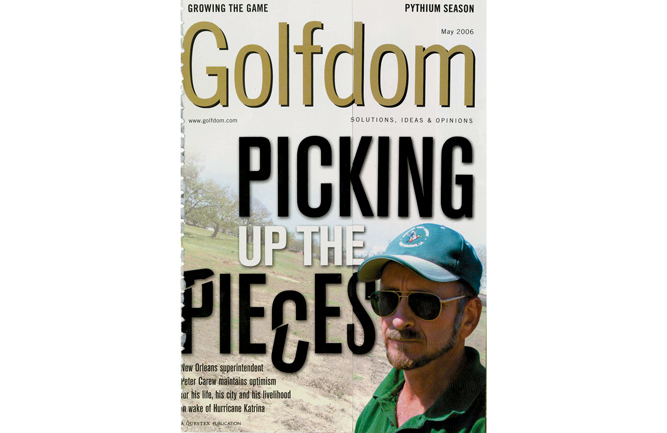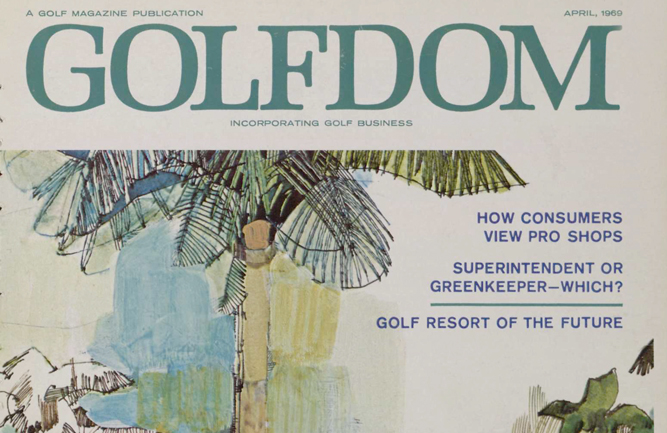The Golfdom Files Extended: Golf business in Japan: taking lessons from U.S.?
In the April edition of The Golfdom Files we pulled from our February 1977 magazine when Golfdom was known as Golf Business (If a singer named Johnny Cougar can change his name to John Cougar Mellencamp and then John Mellencamp than Golfdom can tryout another name too, alright.)
In that magazine Mac Hunter, a former golf professional and then-golf manufacturer, focused on the growth of golf in Japan and the connection between the country’s relatively young golf market and the United States after his trip to The Land of the Rising Sun.
Golf is a brisk business in Japan — at least until it comes down to the business of playing it.
Indeed, one jet-age connotation applicable to The Land of The Rising Sun is that for an enthusiast to play some of Japan’s 1,000 courses, he’s going to have to greet the sun as it peeks over Mt. Fuji. Japanese golfers are, to put it succinctly, backed up to the teahouse. It may be the only place in the world where a man would need to call to get a starting time on the practice tee.
But the Japanese aren’t complaining. They happily and homogenously accept conditions as they exist because since the beginning of the “Gorufu” boom they haven’t known conditions any different. So what if many of Japan’s 16 million golfers rarely swing a club at any place other than her 5,000 driving ranges? So what if many of those driving ranges are three-decked enclosed edifices where a man simply hits a ball into a net at fairly close range? That’s okay, too.
They are keen students of the game. They will drive for miles just to see an American give an exhibition, which, apart from osmosis and voracious reading, is one of the few methods available to them for learning the techniques of the swing.
What about the pro?
The pro doesn’t instruct much. Perhaps he could, but he doesn’t. He is not the driving force of the business that his Yankee counterpart has always been. In Japan, he is an employee of the club — basically a goodwill ambassador under contract to one of the huge conglomerates, which own many of the courses built during the boom.
The conglomerates — such as Kokudo Keikaku, the largest of them, which is based on railroads and the Prince chain of luxury hotels — own not only the clubs and the club pros’ contracts, but the shops that sell the equipment in the city as well. Lock stock and barrel.
And when you’re talking about the merchandising of Japanese equipment, barrel — or perhaps bin — is the appropriate term. Golf balls are sold in that manner, in huge containers that sit outside the numerous shops that specialize in golf equipment. There is no need to worry about theft. The Japanese have the lowest crime rate in the world.
Perhaps the golf merchandise shops provide an even more explicit picture of just how resounding the golf boom hit Japan than does the activity at the courses and driving ranges. It is not uncommon to find up to 20 such shops in one “unio” — an area encompassing three to four blocks. They open for business at 9 a.m. and close at 9 p.m. seven days a week. Sundays, as a rule, traffic is re-routed from certain parts of Tokyo, such as Ginza, to permit unimpeded golf shopping.
Picture the mass of humanity following Ray Floyd down the 18th fairway in the last round of the Masters and you get a fair idea of a typical day in a golf merchandise area of Tokyo.
The square footage of the shops is small and cluttered from floor to ceiling. Like everything else in Tokyo, the shops are wedged into cramped areas where no space seems to exist.
How did it begin?
Golf came to trade-conscious Japan through the store window, as opposed to America and England, where the game is rooted in heredity. Mindful of the glut of merchandising that sprang up in this country during the affluent sixties, the perceptive and innovative Japanese businessman saw the potential for it in his country.
Oh, the game existed in Japan before. But only on a very limited rich man’s scale. It had roughly the same patronage in Japan as polo in the U.S. There were possibly 100 courses in Japan in 1957 when Torakichi (Pete) Nakamura scored what was then considered a major upset in the Canada Cup matches (now World Cup) by defeating Sam Snead, Gary Player, and Dave Thomas of Wales by seven strokes while finishing the tournament 14 under par.
Not long after Nakamura’s victory, the Japanese began to realize that golf, with its mind-over-matter and will-power demands, was ideally suited to their Zen Buddhist philosophy. “… In playing golf a person must learn to control many emotions and make the best expression of himself,” suggested Tokuchika Miki, son of a Zen Buddhist priest.
In the years since, golf has rivaled baseball in Japan for through infiltration. Originally a game for millionaires, it reached into the lower echelons of business executives as they saw their bosses play and then got invited to play themselves. Finally, it has filtered into the working class with the construction of driving ranges.
Western influence
The influence of American technology can be detected in all aspects of golf in Japan. Robert Trent Jones and his son have contributed to course design. So have Jack Nicklaus and Arnold Palmer. In fact, most of the major American equipment manufacturers have a Japanese counterpart. “Made in USA” golf equipment is as much in demand now as watches, shoes, purses, etc., have long been to the style-oriented Japanese consumers.
There is also a growing awareness of the importance of display. Representatives of Japanese merchandisers have visited my company as well as others to assimilate new methods. While the golf shop in Japan is comparable to what it was in the U.S. 20 years ago, there is a growing awareness of what junkiness is going out of style, and that to ensure that merchandise keeps moving, something must be done to make it more attractive. There is an urgent move toward refinement through better counter displays and other merchandising techniques.
The lag is understandable. Golf grew so rapidly in Japan that no one needed to concern himself with making the product attractive. It was merely a matter of turning a fast yen by converting a shop that previously may have sold all manner and means of merchandise into a golf shop to keep pace with the demand. This is not to say that the shops are poorly operated; U.S. merchandising has pressured them into being competitive.
Advertising, in a country roughly the size of Montana, is a simple process. There are no large overhead costs to be absorbed. The golf magazines of Japan are printed on inexpensive paper, and a merchandiser or manufacturer has only to buy space in a couple of them to reach a market that may produce a gross revenue of up to $5 million.
The figurehead pro is no more the merchandiser than he is the teacher. He couldn’t care less. If he has his hand out, it is merely to greet the clientele. Unless he is a playing pro, such as Jumbo Ozaki or Takashi Murakami, he enjoys no special status or social position. But the evolution of golf in Japan may change that, too.
It is a sport that seems to be rising just like the sun.











